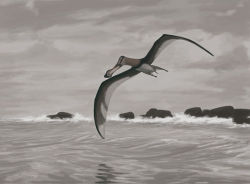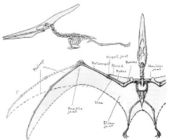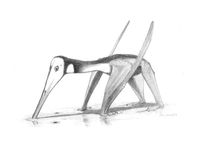|
Pterosaur Conservation status: Fossil |
||||||||||
|---|---|---|---|---|---|---|---|---|---|---|

Coloborhynchus piscator, a Late
Cretaceous pterosaur.
|
||||||||||
| Scientific classification | ||||||||||
|
||||||||||
|
Rhamphorhynchoidea Pterodactyloidea |
Pterosaurs (/ˈtɛ.rəˌsɔː(r)/, from the Greek "πτερόσαυρος", meaning winged lizards, often referred to as pterodactyls, from the Greek "πτεροδάκτυλος", meaning "winged finger" /ˌtɛ.rəˈdæk.tɪl/) were flying reptiles of the clade Pterosauria. They existed from the late Triassic to the end of the Cretaceous Period (228 to 65 million years ago). Pterosaurs were the first vertebrates to evolve flight. Their wings were formed by a sophisticated membrane of skin stretching from the thorax to a dramatically lengthened fourth finger. Earlier species had long, fully-toothed jaws and long tails, while later forms had a highly reduced tail, and some lacked teeth.
Contents |
Fossil evidence
Pterosaurs were first discovered in 1784 by the Italian naturalist Cosimo Collini. He initially believed that pterosaurs were aquatic animals, not flyers. In the 19th century Georges Cuvier proposed that pterosaurs flew.
At least 60 genera of pterosaurs have been found, ranging from the size of a small bird to wingspans in excess of 10 meters (33 feet). Since the first pterosaur fossil was discovered in the late Jurassic Solnhofen limestone in 1784, twenty-nine kinds of pterosaurs have been found in those deposits alone. Most paleontologists now believe that pterosaurs were adapted for active flight, not just gliding as was earlier believed.
Most pterosaur fossils did not preserve well. Their bones were hollow and, when sediments piled on top of them, the bones were flattened. The best preserved fossils have come from the Araripe Plateau, Brazil. For some reason, when the bones were deposited, the sediments encapsulated the bones, rather than crushing them. This created three-dimensional fossils for paleontologists to study. The first find in the Araripe Plateau was made in 1974.

Anatomy
Pterosaurs were highly modified from their reptilian ancestors for the demands of flight.

Pterosaur wings were formed by membranes of skin and other tissues, strengthened by various types of closely spaced fibers. The membranes attached to the extremely long fourth finger of each arm and extending along the sides of the body. A novel bone called the pteroid connected to the wrist and helped to support a membrane (the propatagium) between the wrist and shoulder. The pteroid might have been able to swing forward to extend this membrane, although this is very controversial. In later pterosaurs, the backbone over the shoulders fused into a structure known as a notarium, which served to stiffen the torso during flight, and provide a stable support for the scapula (shoulder blade).
Pterosaur's hip sockets were oriented facing slightly upwards, and the head of the femur (thigh bone) was only moderately inward facing, suggesting that pterosaurs had a semi-erect stance. It would have been possible to lift the thigh into a horizontal position during flight.
There has been considerable argument among paleontologists about whether the wings attached to the hindlimbs as well. Fossils of the rhamphorhynchoid Sordes, the anurognathid Jeholopterus, and a pterodactyloid from the Santana formation demonstrate that the wing membrane did attach to the hindlimbs, at least in some species. However, modern bats and flying squirrels show considerable variation in the extent of their wing membranes and it is possible that, like these groups, different species of pterosaur had different wing designs. Many if not all pterosaurs also had webbed feet, and although these have been considered to be evidence of swimming, webbed feet are also seen in some gliding animals such as colugos (the "flying lemurs"), and may have had an aerodynamic function.
Pterosaur bones were hollow and air filled, like the bones of birds. Unlike typical reptiles, pterosaurs had a keeled breastbone that was developed for the attachment of flight muscles and a brain that was more developed than comparable dinosaurs of similar sizes.
Hair
There is no fossil evidence of feathers, but pterosaurs were unique among reptiles in that at least some of them were covered with hair, similar but not homologous to mammalian hair. Pterosaur hair is not true hair; it is a form of extremely thin fiberous "scales". Although in some cases fibers in the wing membrane have been mistaken for hair, some fossils such as those of Sordes pilosus (the "hairy demon") do show the unmistakable imprints of hair on the head and body, not unlike modern-day bats, an interesting example of convergent evolution. The presence of hair (and the demands of flight) imply that pterosaurs were warm-blooded ('endothermic').
Ground movement

There has been considerable debate in the past about whether pterosaurs moved about on the ground as quadrupeds or as bipeds. A large number of pterosaur trackways are now known, with a distinctive four-toed hind foot and three-toed front foot; these are the unmistakable prints of pterosaurs walking on all fours. However, it might be too much to conclude that all pterosaurs were quadrupedal, all the time.
It has been suggested that smaller pterosaurs with longer hindlimbs such as Dimorphodon might have walked or even run bipedally, in addition to flying, not unlike modern road runners. Other small pterosaurs such as Rhamphorhynchus may have scurried around on all fours. Larger pterosaurs with proportionately smaller hindlimbs and massive forebodies are generally thought to have moved about on all fours while on the ground.
Behavior
A pterosaur egg has been found in the quarries of Liaoning, the same place that yielded the famous 'feathered' dinosaurs. The egg was squashed flat with no signs of cracking, so evidently the eggs had leathery shells. The wing membranes were unusally well developed for a hatchling in an egg, suggesting pterosaurs were ready to fly soon after birth, though whether a parent took care of them is unknown. Very young animals have been found in the Solnhofen limestone beds, where they presumably flew to the middle of a lagoon, fell in and drowned.
A study of pterosaur brains using X-rays has revealed extraordinary information about their habits. Studying fossil pterosaur skulls is extremely difficult because they are so delicate, but Lawrence Witmer at Ohio University in Athens and his colleagues used X-ray CT scans to build up 3D images of the brains of two species. One striking finding was that the animals (Rhamphorhynchus muensteri and Anhanguera santanae) had massive flocculi. The flocculus is a brain region that integrates signals from joints, muscles, skin and the balance organs.
The pterosaurs' flocculi occupied 7.5 % of the animals' total brain mass, more than in any other vertebrate. Birds have unusually large flocculi compared with other animals, but these only occupy between 1 and 2 % of total brain mass. "It is just ridiculously large in pterosaurs," says Witmer.
The flocculus sends out neural signals that produce small, automatic movements in the eye muscles. These keep the image on an animal's retina steady. Pterosaurs probably had such a large flocculus because of their large wing size. This extra area meant that there was a great deal more sensory information to process.
Pterosaurs are known to have been attacked by spinosaurs. In the 1 July 2004 edition of Nature, paleontologist Eric Buffetaut discusses an early Cretaceous fossil of three cervical vertebrae of a pterosaur with the broken tooth of a spinosaur embedded in it. The vertebrae are known not to have been eaten and exposed to digestion, as the joints still articulated.
Evolution and extinction
Because pterosaur anatomy has been so heavily modified for flight, and immediate "missing link" predecessors have not so far been described, the ancestry of pterosaurs is not well understood. They are generally, but not universally, thought to be related to the Dinosauria on the basis of their ankle structure.
They are thought to have evolved flight from some manner other than the 'tree-down' route possibly taken by birds, because pterosaurs demonstrated no adaptations useful for tree living. Most scenarios have pterosaurs evolving from long-legged, ground-running ancestors like Scleromochlus or Sharovipteryx (a less likely scenario), both of which had webs of skin from long hind legs to their bodies or tails. This suggests a 'ground-up' evolution of flight or even a route that evolved by gliding from cliff-tops.
It is believed by some that competition with early bird species may have resulted in the extinction of many of the pterosaurs. By the end of the Cretaceous, only large species of pterosaurs survived. The smaller species were extinct, and replaced by birds. At the end of the Cretaceous period, the great extinction which wiped out all dinosaurs, and many other animals, seemed to also take the pterosaurs. Others suggest that most pterosaurs were specialised for an ocean-going lifestyle. Consequently, when the K-T mass-extinction severely affected marine life that most pterosaurs fed on, they went extinct. A lack of small pterosaurs in the fossil record could be explained by competition with birds or poor preservation due to the fragility of their skeletons.
A recent dissertation by Momchil Atanassov describes two new specimens from the Late Triassic Dockum Formation of Texas that may reveal a lot of new information about the origins of pterosaurs. They still have yet to be formally described.
Classification of pterosaurs has traditionally been difficult, because there were many gaps in the fossil record. Many new discoveries are now filling in these gaps and giving us a better picture of the evolution of pterosaurs. Traditionally, they are organized into two suborders:
- Rhamphorhynchoidea (Plieninger, 1901): The early, or basal pterosaurs, and had long tails and short wing metacarpals. They were small, and their fingers were still adapted to climbing. They appeared in the late Triassic period, and lasted until the late Jurassic.
- Pterodactyloidea (Plieninger, 1901): The more derived pterosaurs, with short tails and long wing metacarpals. They appeared in the middle Jurassic period, and lasted until the Cretaceous-Tertiary extinction event wiped them out at the end of the Cretaceous.
However, the Rhamphorhynchoidea are a paraphyletic group, so with the increasing use of cladistics it has fallen out of favor.
- ORDER PTEROSAURIA (Extinct)
- Family Dimorphodontidae
Family Anurognathidae
Family Campylognathoididae
Family Rhamphorhynchidae - Suborder
Pterodactyloidea
- Superfamily
Ornithocheiroidea
- Family Ornithodesmidae
Family Ornithocheiridae
Family Pteranodontidae
Family Nyctosauridae
- Family Ornithodesmidae
- Superfamily
Ctenochasmatoidae
- Family Pterodactylidae
Family Ctenochasmatidae
- Family Pterodactylidae
- Superfamily
Dsungaripteroidea
- Family Germanodactylidae
Family Dsungaripteridae
- Family Germanodactylidae
- Superfamily
Azhdarchoidea
- Family Tapejaridae
Family Azhdarchidae
Family Tupuxuaridae
- Family Tapejaridae
- Superfamily
Ornithocheiroidea
- Family Dimorphodontidae
Well-known genera
Examples of pterosaur genera include:
- Dsungaripterus had a wingspan of 3 metres (10 feet), an unusual bony crest running along its snout, and long, narrow, curved jaws with a pointed tip. It lived during the early Cretaceous period.
- Pteranodon was 1.8 metres (six feet) long, with a wingspan of 7.5 m (25 feet), and lived during the late Cretaceous period.
- Pterodactylus had a wingspan of 50 to 75 centimeters (20 to 30 inches), and lived during the late Jurassic on lake shores.
- Pterodaustro was a Cretaceous pterosaur from South America with a wingspan around 1.33 metres and with over 500 tall, narrow teeth, which were presumably used in filter-feeding, much like modern flamingos. Also like flamingos, this pterosaur's diet may have resulted in the animal having a pink hue. It was South America's first pterosaur find.
- Quetzalcoatlus had a wingspan of 12 metres (40 feet) but weighed only 50 kilograms (110 pounds), and lived during the late Cretaceous period.
- Rhamphorhynchus was a Jurassic pterosaur with a vane at the end of its tail, which may have acted to stabilise the tail in flight.
Further reading
- Unwin, David M. (2006). Pterosaurs From Deep Time. Pi Press: New York. ISBN 0-13-146308-X
- Wellnhofer P (1991): Illustrated Encyclopedia of Pterosaurs, Crescent Books
- Bramwell, C. and G. R. Whitfield (1974). Biomechanics of Pteranodon. Philosophical Transactions of the Royal Society B 267: 503-81.
External links
- Pterosaur FAQ's, by Raymond Thaddeus C. Ancog.
- The Pterosaur Database, by Paul Pursglove.
- The Pterosauria, by Mike Hanson.
- Comments on the phylogeny of the pterodactyloidea, by Alexander W. A. Kellner. (technical)
- Pterosaurs no bird brains